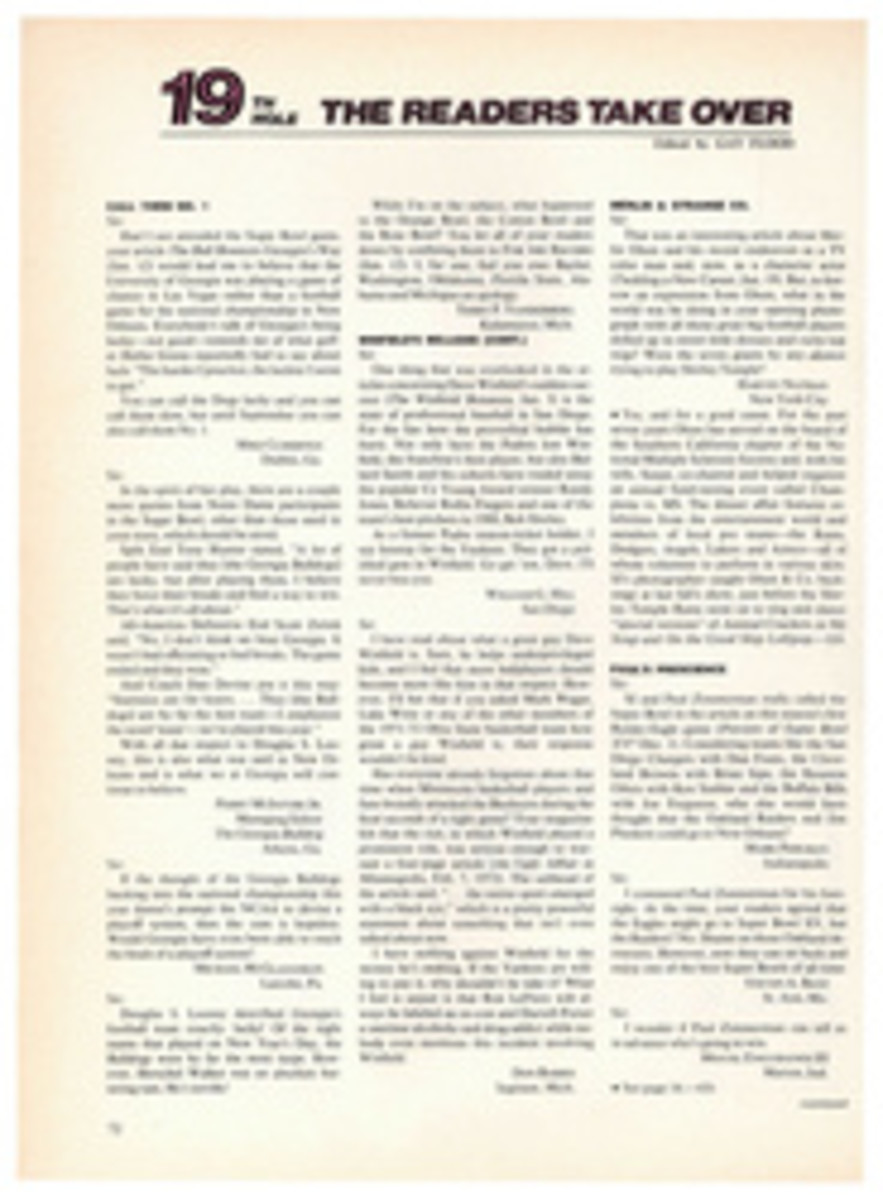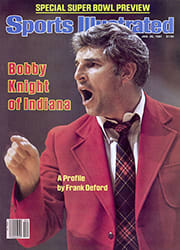
A LESSON FROM A MASTER
If the Grand Prix Masters tennis tournament were a midterm exam, it might go something like this:
True or false: 1) Bjorn Borg lost two penalty points by arguing (what?) over a line call but won another point without even holding onto his racket. 2) John McEnroe lost all three of his singles matches but won a standing ovation (what?) by slamming a ball into the seats.
Multiple choice: Which one of the following denizens of Madison Square Garden positively, cross his heart, didn't blatantly go into the tank?
a) Borg, b) McEnroe, c) Ivan Lendl, d) Andy Warhol.
Short Answer Question: Describe Lendl's appearance and haberdashery without using any terms usually associated with punk rock or the plumbing trade.
Essay Question: Explain in 25,000 words or less why the Masters is often the most chaotic, frustrating and outrageous excuse for a tennis tournament there is. Also, why it's sometimes the best.
If anyone answered true, true, D, enigmatic and impossible, he should instantly begin constructing a different round-robin format under which the Masters could be played, so that the potential for at least some of these peculiar goings-on might be erased. Not that any system necessarily would have changed the lineup for Sunday's final, in which the defending champion, Borg, met the wonder Czech, Lendl, in a rather anticlimactic encounter reminiscent of last year's closing match, in which Vitas Gerulaitis (R.I.P., Tiny Dancer) won just four games in two sets off Borg. This time the 20-year-old Lendl—not yet ready for the big victory on the big occasion—got eight games in three sets, Borg cruising 6-4, 6-2, 6-2.
Borg's awesome display aside, this result didn't live up to the mostly magnificent tennis that had been displayed all week. That is, of course, when certain people were trying.
Which was only some of the time, under the Masters' bizarre use of a preliminary round robin to eliminate four of the eight competitors. Take Lendl in his last preliminary match, against Jimmy Connors. Connors prevailed 7-6, 6-1 when Lendl became Ivan the Terrible in the second set. Or consider Borg in his final preliminary, against Gene Mayer, which Mayer won 6-0, 6-3. Borg loses love-6? Case closed on the need for a revamped system.
As it was, McEnroe was the only member of the three musketankers to own up to taking a dive. Came right out with it. Junior did. "I wasn't into it," he said after falling 6-3, 6-0 to Jose Luis Clerc in their round-robin—make that lame-duck—final. "Maybe it would've been better not to play at all, but I didn't want to create a scene."
Speaking of which, before the scenario becomes any more complicated, one needs to go back to the beginning of the tournament and the man who was ultimately responsible for the skulduggery to follow: Mayer.
Even with the presence of the usual Masters heavies and Lendl, the most intriguing figure in the draw was the baby-faced, silver-tongued Mayer. After all, it isn't often one finds a 6-foot, 150-pounder who's a notorious trencherman, but Mayer has downed a dozen eggs or several pounds of vegetables or seven Big Macs—Tim Gullickson counted 'em—at a single sitting. He's also the heretofore unknown brother of veteran Sandy Mayer and a gambler who swashbuckles his oversized Prince racket two-handed from both sides. And he's the touch artist who, despite a string of injuries over the past three years, has jumped from 148th in the world computer standings to 12th to fourth. That's Gene Mayer.
On opening night in New York he created total havoc by jumping all over McEnroe, beating him 3-6, 7-6, 6-2 despite 17 aces from Junior, who had to battle stomach pains, a pulled muscle in his left leg and his chronic sore back in addition to the voracious Mayer.
What this upset, combined with Mayer's subsequent 6-3, 7-5 victory over Clerc, did was force McEnroe into the position of having to defeat his partner-in-legend, Borg, on Thursday night to remain alive in the tournament. Oh, what a night it was! The Knicks and the Rangers should have such good times at the Garden. Scalpers (cleaning up at $40 per); celebrities (Warhol, David Merrick, Robert Duvall, Henry Kissinger); a packed house (19,103); heavyweight championship atmosphere (Raging Mac vs. Sugar Bjorn). Even Connors, who has been eclipsed by the two younger men, called it "another classic matchup."
And it was. McEnroe's rhythm and texture were missing early as Borg won the first set 6-4, and Bjorn came from behind in the second to serve for the match at 6-5. But another dramatic chapter in the rivalry quickly unfolded after McEnroe struck a winning lob and a drop volley to square the set.
At 3-all in the tie-breaker, Borg's forehand pass was signaled good by the base linesman, but Umpire Mike Lugg, an Englishman sporting a handlebar moustache whose handlebars had apparently fallen off, overruled him, giving McEnroe the point and a 4-3 lead. Then a funny thing happened. Borg frowned. He strolled to the chair. He...yes, he...disputed the call. (Quick, phone That's Incredible.) With the crowd booing and whistling, Borg quietly implored Lugg to ask the linesman about the call. Lugg would not Lugg ordered Borg to continue play and put the 30-second clock on him. Borg stood his ground. Lugg awarded a delay-of-game penalty point to McEnroe.
"I couldn't believe it," McEnroe remembered thinking. "Just imagine what the crowd would have done to me in that situation."
Dick Roberson, chief of the Grand Prix supervisors, came out to talk to Borg. Still Bjorn stood by the chair. Lugg gave McEnroe a second penalty point. Then, almost imperceptibly, Borg glanced at his mentor, Lennart Bergelin, in the stands. Bergelin slowly stood up and sat down again. Borg walked out to resume play.
"I was very mad, very disappointed," he said later. Did he think about quitting? "No."
Behind now 6-3 in the tie-breaker, Borg banged an out-ball to lose the set. But immediately he became much more aggressive. Both men served two love games in the third set, and McEnroe once purposely drilled the ball into the crowd to give Borg a point another call had denied him. Junior then bowed deeply as the cheering swelled. There were no break points as the great rivals battled to yet another tie-breaker.
This time, at 2-3 on serve, McEnroe's southpaw slice delivery wasn't wide enough, and Borg cracked a backhand return winner. That was the crucial arrow. A weary McEnroe made three more mistakes—a netted backhand volley and two miserable approaches—and it was over 19 minutes past midnight, 6-4, 6-7, 7-6. "A match high up on my list," said the winner.
Then came Tank Friday. First McEnroe, already eliminated from contention, gave in to Clerc. Then Borg, who couldn't get to sleep until 4 a.m., surrendered to Mayer. Back to back, a total of six games won by the two best players in the world. As a result of all this, Mayer, having finished with a 3-0 record in the blue round robin, now would play the loser of Connors-Lendl from the red group, the winner to draw Borg. "Get out the diving scorecards," somebody said. "Connors-Lendl will be a real three-meter springboard job."
After blowing two set points and collapsing 7-1 in the first-set tie-breaker, Lendl took the full plunge, spraying balls into the far reaches of Gotham. Connors, incensed at the Czech's obvious lack of effort, waved him off after the postmatch handshake and then called him "chicken. I don't understand how a player with his talent and future could act like that."
The next day Lendl, oozing confidence, brushed off Mayer in straight sets. Then he brushed off the media with what sounded suspiciously like clucking noises. "I changed my tactics the other night and it didn't work," Lendl said. "It happens sometimes."
Connors' tactics against Borg in their semifinal were the same as always: blast away, wear your guts on your sleeve. Again working to Jimbo's vulnerable forehand off short balls, Borg took the opening set and, winning 12 of 13 points, broke at love for a 3-2 lead in the second set.
But Connors never goes quietly. Roaring and wild gesturing—mostly toward his wife, Patti—accompanied Connors' comeback as he bounced off the ropes time and again, nicking the corners with backhand drives, lunging for volleys, chasing and overtaking everything Borg offered. To save the second set at 5-6, Borg had to serve with such violence that his racket flew up to the net. But Connors' return was wide, point to Borg. The tie-breaker, however, went 7-4 to Connors, who hit four clean winners.
In the deciding set, Borg jumped ahead 5-1 and again Connors seemed finished. But he wasn't. He fought off one match point, broke for 5-2, held to 5-3 and had two more break points for 5-4, one a Connors meat-and-potatoes, gimme-a-backhand pass. "I had Bjorn dead in my sights to go right at him, then I changed my mind," Connors said. On such indecision rests defeat. Three match points later, Borg had beaten Connors, 6-4, 6-7, 6-3, for the eighth straight time. But it was, Borg said, "the best match Jimmy been playing me in a long time."
Came the morrow and Lendl couldn't reach down for his best—the chicken turned into a turkey—simply because Borg wouldn't let him.
In Basel, Switzerland on Oct. 19, 1980, Lendl had defeated Borg over five sets by staying in the backcourt, but that was the Swede's first tournament in more than six weeks. This time Borg took Lendl's vicious power swipes and sent them back with more pace and angle. He even looked comfortable at net with some sharp volleys. A marvelous low backhand retrieve off one of Lendl's bullets that Borg was able to slide down the line for a winning break at 2-1 in the second set seemed to take the spirit from the challenger.
The fury with which Lendl was dispatched underscored Borg's feeling that this was a critical tournament. He'd had a desultory fall and winter, losing in Tokyo and retiring in Bologna because of illness. His motivation was being questioned. His new floppy shirts made him look like Olaf the Tentmaker. Then came the Masters and his duplication of last year when he laid waste to Connors and McEnroe in the preliminary rounds and coasted in the final.
Borg was asked why he played better against Lendl on Sunday than against Mayer on Friday. "Because it was the final," Borg said. Then he smiled.
Ah, that Bjorn. Same old jokester. Same old player.
PHOTO
WALTER IOOSS JR.
Borg hasn't won the U.S. Open in Queens, so when it comes to New York City, he'll take Manhattan.
PHOTO
WALTER IOOSS JR.
Lendl easily qualified for the semis, then routed Mayer, but in the final against Borg he was Ivan the Terrible.
PHOTO
WALTER IOOSS JR.
Uncharacteristically arguing a close call, Borg was penalized two points for overstaying his welcome.
PHOTO
WALTER IOOSS JR.
The Masters was no fling for injured McEnroe.
PHOTO
WALTER IOOSS JR.
Jimbo's loss and racket were hard to swallow.
PHOTO
WALTER IOOSS JR.
Mayer: two-fisted with his forehand and his fork.

